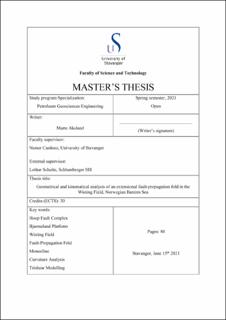| dc.description.abstract | The Wisting field is located on the Bjarmeland Platform northeast of the Maud Basin and adjacent to the Hoop Fault Complex. It is Norway’s northernmost oilfield to be developed. 3D high resolution P-Cable seismic data from the field display shallow (< 200 m below the seabed) monoclines in Upper Jurassic – Lower Cretaceous strata above normal faults, while the Upper Triassic – Middle Jurassic strata are faulted. These monoclines are extensional fault-propagation folds. This thesis analyzes one of these monoclines along a NNE-SSW fault. The purpose of the study is to characterize geometrically the monocline. In addition, trishear modelling is performed on four sections across the monocline, to reconstruct fold growth, strain, and potential minor structures. The interpreted Upper Triassic to Lower Cretaceous horizons (intra-Fruholmen to top Kolje formations) are pre-tectonic successions. The main tectonic event in this area was in the Early Cretaceous (Aptian–Albian), during the deposition of the Kolmule Formation. Fault throw is greatest towards the NE (~60 m) where the fault breaches the monocline. Towards the SW, the throw decreases and it is transferred to another fault in a relay structure. Bedding data and curvature analysis show that the monocline approaches a cylindrical shape. Trishear modeling indicates that the fault propagated from the Upper Triassic to the Upper Jurassic successions along most of its length. However, in the northernmost section, the fault propagated from the Middle Jurassic to the Lower Cretaceous successions. The predicted fault slip is consistent with the interpretation, but the predicted fault propagation to slip (P/S) decreases from south (P/S = 2.8) to north (P/S = 2.2). Areas on the forelimb of the monocline subject to higher strain magnitudes and potential high-angle fractures could be prone to fluids migrating to the surface. The evolution of the monocline is related to the mechanical stratigraphy; the folded upper strata mainly consist of shale and are ductile, while the lower faulted strata mainly consist of sandstones and are brittle. | |
